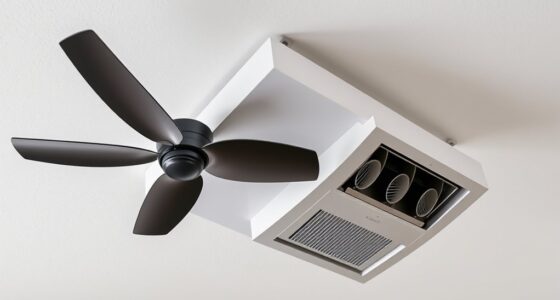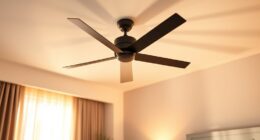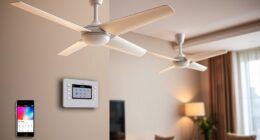Ceiling fans use much less energy than HVAC systems, typically consuming between 15 to 75 watts depending on speed and size. They create a cooling breeze without lowering air temperature, making them budget-friendly and energy-efficient. HVAC units, on the other hand, use considerably more power, often costing more over time due to their larger energy demand. To uncover how to maximize savings and efficiency, explore the factors that influence their performance and your home’s needs.
Key Takeaways
- Ceiling fans consume 15-75 watts, significantly less than HVAC systems, which often use several hundred watts to several kilowatts.
- Fans mainly circulate air, reducing cooling costs, while HVAC units actively heat or cool, leading to higher energy consumption.
- Operating a ceiling fan is generally more cost-effective over time due to lower power usage and energy-efficient features.
- Proper insulation and placement enhance the efficiency of both, but HVAC efficiency heavily depends on duct sealing and system maintenance.
- Combining ceiling fans with smart thermostats and insulation optimizes energy savings compared to relying solely on HVAC systems.
How Much Energy Do Ceiling Fans Consume?

Ceiling fans are known for their energy efficiency, but you might wonder exactly how much power they use. Typically, a ceiling fan consumes between 15 to 75 watts, depending on the size and speed setting. To maximize energy savings, follow some simple energy saving tips, like turning off fans when rooms are unoccupied. Proper fan placement also matters: installing fans in the center of a room ensures ideal airflow and efficiency. Ceiling fans don’t cool air directly but create a breeze that makes you feel cooler, reducing the need for air conditioning. This way, you can lower your energy bills while maintaining comfort. Understanding your fan’s power consumption helps you make smarter choices and get the most out of your energy-efficient appliances. Additionally, selecting fans with energy-efficient features can further reduce power usage and enhance overall savings.
The Power Usage of HVAC Systems
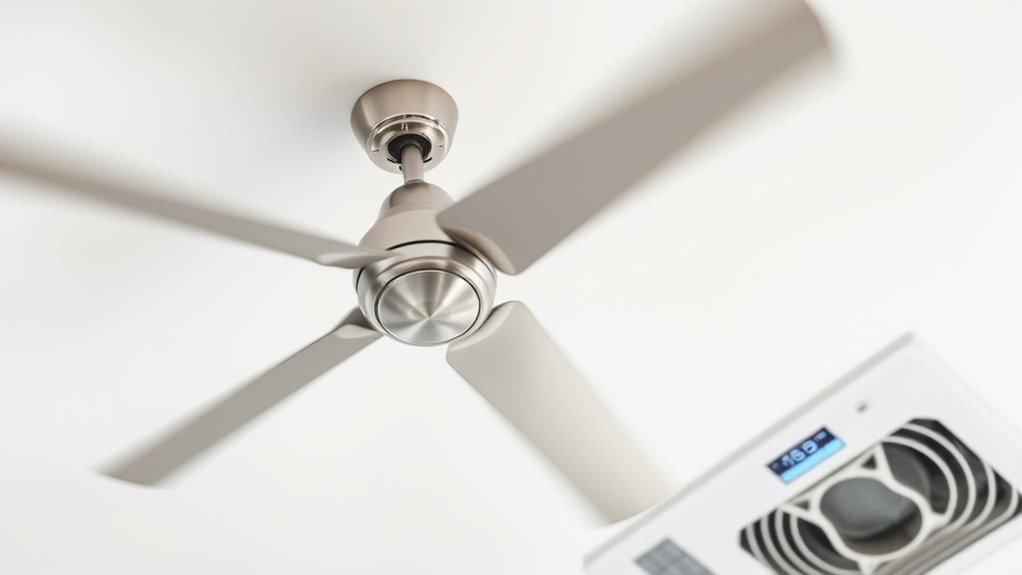
HVAC systems typically consume considerably more energy than ceiling fans, especially when running for extended periods. A significant factor is their reliance on large compressors and extensive ductwork, which can lose energy if ducts aren’t efficient. Upgrading to smart thermostats helps optimize usage by adjusting temperature settings based on your schedule, reducing unnecessary operation. Duct efficiency plays a vital role; poorly insulated or sealed ducts cause energy losses, making your system work harder and increasing power consumption. HVAC units also run for longer durations to reach set temperatures, unlike ceiling fans that circulate air without heating or cooling. While HVACs provide temperature control, their higher energy use makes it essential to improve duct efficiency and leverage smart thermostats to save power. Additionally, integrating Honda tuning modifications such as ECU remapping can improve engine efficiency in vehicles, indirectly reducing energy consumption overall.
Comparing Operating Costs Over Time
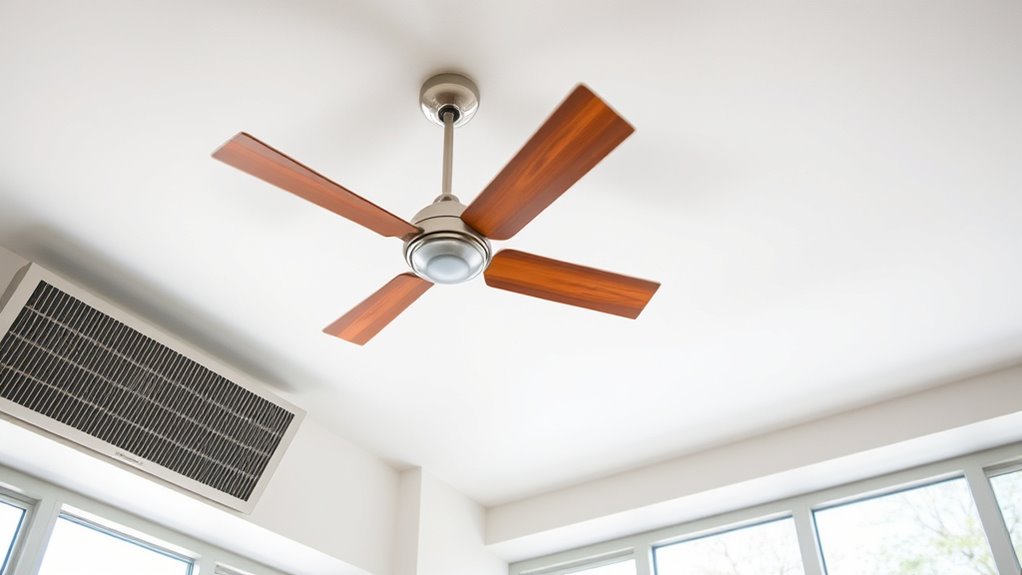
Over time, the operating costs of ceiling fans and HVAC systems can differ substantially, impacting your budget differently depending on how you use them. Ceiling fans typically cost less to run, offering significant cost savings and reducing environmental impact. In contrast, HVAC systems consume more energy, leading to higher expenses and a larger carbon footprint. Your usage habits play a crucial role in these costs; running a ceiling fan for hours can be cheaper than frequently turning on your HVAC. The table below highlights the potential savings:
| Ceiling Fan | HVAC System |
|---|---|
| Lower energy costs | Higher energy costs |
| Less environmental impact | Greater environmental impact |
| Better for budget over time | More expensive long-term |
Being aware of energy consumption patterns can help optimize your choice and maximize savings over time. Additionally, understanding operating efficiency can guide you toward more sustainable and cost-effective cooling options. Recognizing how decor style influences your overall energy use can further support your efforts to reduce costs and environmental impact.
Factors Influencing Energy Efficiency

Several factors directly influence the energy efficiency of both ceiling fans and HVAC systems, shaping how much energy they consume during operation. Air circulation plays a vital role; effective airflow helps maintain comfort with less energy, reducing strain on your system. Proper placement and speed settings optimize air movement, minimizing unnecessary power use. Additionally, the environmental impact of your choice depends on insulation quality, home size, and climate. Well-insulated spaces require less energy to heat or cool, making both ceiling fans and HVAC systems more efficient. The age and maintenance of equipment also matter—older or poorly maintained units tend to consume more energy. Regularly upgrading to newer, more efficient models, such as Kia Tuning enhancements, can also improve overall performance and reduce energy consumption. Proper system insulation and sealing can significantly improve efficiency by preventing energy loss. Understanding these energy efficiency factors allows homeowners to make smarter decisions that improve energy efficiency and reduce their overall environmental footprint.
Making the Smart Choice for Your Home

Choosing between a ceiling fan and an HVAC system depends on your home’s specific needs, budget, and energy goals. To make the smart choice, consider investing in a smart thermostat, which optimizes your HVAC’s efficiency and reduces energy waste. Additionally, upgrading your insulation can considerably cut heating and cooling costs, making either option more effective. If your home has good insulation, a ceiling fan might be enough to keep you comfortable without high energy bills. For larger or poorly insulated spaces, an HVAC system paired with a smart thermostat ensures precise temperature control while conserving energy. Implementing energy-efficient appliances and proper ventilation can further enhance your home’s overall energy savings. Developing a proactive mindset can also help you stay committed to energy-saving strategies over time. Being aware of home energy use and making informed choices allows you to optimize comfort and savings, helping you select the most efficient solution tailored to your home’s unique requirements.
Frequently Asked Questions
How Do Climate Conditions Affect Fan and HVAC Energy Efficiency?
Climate conditions greatly impact your fan and HVAC energy efficiency. When outdoor temperatures rise, your HVAC works harder, increasing energy use, while fans help cool spaces without much energy. High humidity levels make cooling more difficult, causing your systems to run longer. Conversely, cooler or dry conditions reduce strain on both fans and HVAC units. By adjusting usage based on climate, you can optimize energy efficiency and save on costs.
Can Ceiling Fans Reduce the Need for Air Conditioning?
Think of a ceiling fan as a invigorating breeze that can cut your cooling costs. Yes, it can reduce your reliance on air conditioning, especially during mild days. While installation costs are lower and the ongoing energy use is minimal, keep in mind that fans don’t cool the air but circulate it. A smart combination of fans and HVAC can be your wallet’s best friend, saving you money in the long run.
What Maintenance Impacts the Energy Performance of HVAC Systems?
You should regularly maintain your HVAC system to keep it energy-efficient. Replace filters every 1-3 months to guarantee proper airflow and reduce strain on the system. Additionally, sealing leaks in your ducts prevents energy loss, so check for and fix any duct leaks. Proper maintenance like these helps your HVAC operate efficiently, saving you money and reducing energy consumption over time.
Are Energy Savings From Fans Consistent Across Different Room Sizes?
You might think fans save the same amount of energy in every room, but that’s not true! In tiny spaces, fans slash costs dramatically, making them super cost-effective, while in massive rooms, their savings shrink like a snowball melting. Room insulation plays a huge role, helping fans work smarter, not harder. So, your energy savings from fans vary wildly depending on room size and insulation, making them more or less effective.
How Do Smart Home Integrations Influence Energy Consumption?
Smart home integrations boost your energy optimization efforts by allowing you to control devices remotely and set schedules. This means you can automate your heating, cooling, and lighting systems, reducing unnecessary energy use. With smart home tech, you’re more aware of your consumption patterns, so you can make adjustments easily. Overall, these integrations help you save energy consistently, regardless of your room size, by optimizing how and when your appliances operate.
Conclusion
Choosing between a ceiling fan and HVAC isn’t just about costs—it’s about creating a comfortable, inviting space while being kind to your energy bills. By understanding their gentle ways of cooling and heating, you can find a harmonious balance that suits your home and lifestyle. Whichever option you lean toward, you’ll be making a thoughtful decision that warms your home and your heart, all while keeping energy use gracefully in check.



